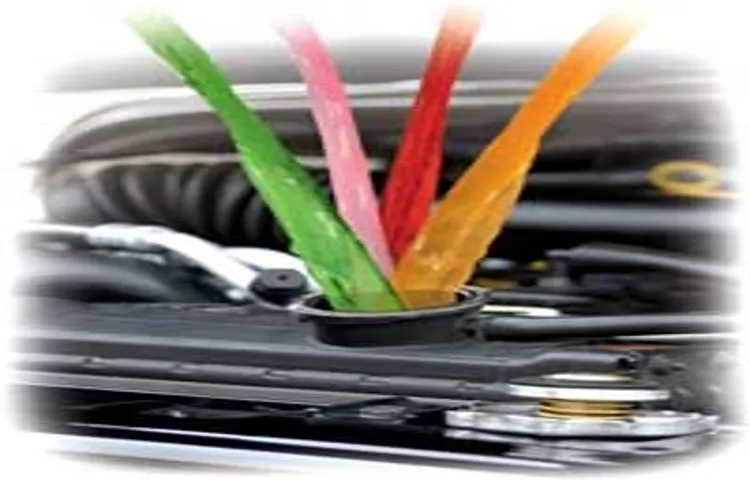If your car’s coolant has changed color, it can be a little alarming. After all, why would something that’s supposed to be green turn orange or brown? The truth is, there are several reasons why coolant can change color, and not all of them are cause for concern. Understanding the causes and potential implications of a coolant color change can help you determine whether or not it’s something you need to address right away.
So, what are some of the factors that can cause a coolant color change, and what should you do if it happens to your car? Let’s take a closer look.
Table of Contents
What is coolant?
Have you ever looked under the hood of your car and wondered why the color of your coolant has changed? Coolant, also known as antifreeze, is a liquid substance that flows through your car’s engine to regulate the temperature and prevent it from overheating. It’s typically a bright, neon green color when brand new, but over time, the color can change to pink, red, orange, or even brown. So why does this happen? The main reason is due to the additives in the coolant breaking down over time, causing a chemical reaction that alters the color.
Other factors, such as exposure to air or contaminants, can also contribute to the color change. However, the most important thing to remember is that regardless of the color change, your coolant still needs to be changed periodically to ensure your engine remains cool and protected from overheating and damage.
Explanation of coolant and its importance
Coolant is a liquid substance that is used to maintain the temperature of a machine or engine. It is typically a mixture of water and antifreeze, which helps to regulate the heat and prevent the engine from overheating. Coolant is an essential component of any engine, as it plays a vital role in maintaining the proper functioning of the engine.
Without coolant, engines can become damaged due to overheating, leading to costly repairs. In addition to cooling the engine, coolant also helps to prevent rust and corrosion, providing much-needed protection to the engine’s various components. Regular maintenance of the coolant system is essential to ensure that your engine stays in good working condition.
By changing the coolant at recommended intervals, you can prolong the life of your engine and avoid costly repairs. So, it’s important to make sure that your engine’s coolant is always at the correct level and mix ratio, and checked regularly to prevent any issues.
What color should coolant be?
“Why did my coolant change color?” If you’ve noticed a change in the color of your coolant, it could be a sign of a problem within your car’s cooling system. Typically, coolant starts out as a bright, vibrant green or yellow color, but over time it can become darker and more brown or rusty looking. This change in color could indicate a few potential issues, such as a leak in the system, a buildup of rust or debris, or a contamination of the coolant itself.
It’s important to address any changes in the color of your coolant right away, as it can often be an early warning sign of more serious issues that could lead to engine damage if left untreated. If you’re not sure why your coolant has changed color, it’s best to take your car to a professional mechanic who can diagnose the issue and recommend the right course of action to get your cooling system back in proper working order.
Explanation of normal coolant color and why it may change
What color should coolant be? Well, typically, coolant should be a bright green color. This color is due to the presence of ethylene glycol, a common ingredient in most coolants. However, it’s important to note that the color of coolant can vary depending on the type of vehicle and the brand of coolant used.
Some manufacturers add dye to their coolant to give it a distinct color, so don’t be alarmed if your coolant is a different color than green. But generally, if your coolant is a dark color, such as brown or black, it’s a sign that the coolant is old and needs to be changed. A reddish color coolant contains Dex-Cool which is used by General Motors in many of their vehicles.
If you’re unsure about the color of your coolant, it’s best to consult your owner’s manual or take your vehicle to a trusted mechanic. It’s also important to note that over time, the color of coolant may change due to contamination from dirt, rust, or debris in the engine. This is why it’s important to maintain your coolant by checking it regularly and changing it when necessary.
Neglecting your coolant can lead to engine overheating, damage, and costly repairs. So, make sure to take good care of your engine coolant and keep an eye on its color to ensure your vehicle is running smoothly. Remember, prevention is always better than cure, and maintaining your coolant is a simple yet crucial part of your car’s overall maintenance and care.
Causes of coolant color change
If you’re wondering why your coolant suddenly changed color, there could be several potential causes. One of the most common reasons for a color shift in your antifreeze is simply normal wear and tear. Over time, the chemicals in your coolant break down, which can cause it to change color or become cloudy.
Another possible cause is contamination. If something foreign, like oil or rust, gets mixed into your antifreeze, it can change its appearance. Additionally, a change in color could indicate a leak in your cooling system, as the mixture of antifreeze and water becomes imbalanced.
Regardless of what’s causing your coolant to change color, it’s important to address the issue as soon as possible to avoid potential engine damage.
Exploring possible reasons for the change in coolant color: contamination, rust, oil, etc.
Coolant color change One of the most common reasons for a change in coolant color is contamination. This can occur when foreign substances like rust, oil, or dirt mix with the coolant, resulting in an alteration of its color. Rust can cause brown or orange discoloration, while oil might turn the coolant yellow or brown.
Dirt might lead to black, muddy-looking coolant. Another reason for a change in coolant color is the presence of rust in the cooling system. Rust-particularly iron oxide- tends to accumulate in areas of the system where the coolant is stagnant and reacts with water to create a rust-colored compound.
It can be a sign of an aging or damaged radiator or any other part of the cooling system. Additionally, the same color change can be observed in the presence of a leaking head gasket, but in this case, the coolant may also appear murky. It’s essential to identify such changes early on and have the system flushed and checked to avoid major damages.
Regular maintenance, checking for leaks, and replacing the coolant as per the manufacturer’s instructions can go a long way in keeping the system free of contaminants and rust.
Common issues that may arise from discolored coolant
If you notice that your car’s coolant has changed color, there may be a more significant issue at play. The color change could indicate a leak, clogged radiator, or damaged gasket. These issues will often cause coolant to either look milky white or have a brownish color.
Alternatively, rusty looking coolant may indicate that rust is present in the engine block or radiator. Another possibility is contaminated coolant, where oil or fuel has mixed in with the coolant. This can sometimes happen when a gasket is damaged, and fluids mix.
It’s essential to have your car inspected by a mechanic if you suspect any of the color changes mentioned above. Neglecting this could lead to more significant and potentially costly problems down the line, such as decreased engine performance, overheating, or engine failure. Overall, keeping an eye on the color of your coolant can be an early indication that something is wrong.
Don’t ignore any changes to the coolant’s color, and always seek professional advice.
What to do when your coolant changes color?
“Why did my coolant change color?” is a question that many drivers ask themselves. The color of your coolant can indicate potential problems with your vehicle’s cooling system. For example, if your coolant changes from its usual bright green or orange color to a milky or rust-colored hue, this could be a sign of a blown head gasket or corrosion in your engine.
If you notice a sudden change in your coolant’s color, it’s a good idea to have your vehicle inspected by a professional mechanic. Failure to address these issues could lead to engine damage or even total engine failure if left unchecked. In some cases, a simple coolant flush and refill may be all that’s needed to fix the issue.
However, it’s always better to err on the side of caution and have your vehicle inspected sooner rather than later to avoid potentially costly repairs down the road.
When to bring your car for professional servicing: signs, evaluation, diagnosis, etc.
If you notice that your car’s coolant has changed color, it may be an indication that something is wrong with your vehicle’s cooling system. Typically, coolant should have a bright green or yellow color, but when it changes to a rusty color, it could mean that it has become contaminated with rust or sediment. This can cause clogs in your cooling system, which may lead to your engine overheating and even cause serious damage.
Therefore, it’s important to bring your car to a professional service center immediately if you notice any discoloration in your coolant. A certified mechanic will be able to evaluate the condition of your coolant and diagnose any issues with your cooling system. They may also perform a flush of your cooling system to remove any contaminants and replenish the coolant with fresh fluid.
By taking prompt action when you notice a change in your coolant’s color, you can help prevent costly repairs and keep your car running smoothly.
Tips for maintaining the coolant system and preventing color changes in the future
If you notice that your coolant has changed color, it could be a sign that your vehicle’s coolant system needs attention. It is important to maintain your coolant system to prevent future color changes and ensure proper engine function. One common cause of color change is the presence of rust in the system, which can lead to clogs and leaks.
Flushing the coolant system and replacing it with fresh coolant can help prevent rust and other contaminants from building up. Additionally, regularly checking the coolant levels and replacing any damaged or worn components, such as the radiator cap or hoses, can prevent leaks and ensure the system is working properly. Remember, neglecting your coolant system can lead to costly engine damage, so it’s essential to stay on top of maintenance.
By following these tips, you can keep your coolant system in top condition and prevent future color changes.
Conclusion
In the immortal words of Queen, ‘Another one bites the dust.’ Your coolant changed color because, sadly, its life had run its course. Over time, coolant can break down, become diluted, and pick up all sorts of nasties – from rusty bits to oil sludge.
So, like a jaded celebrity’s entourage, it’s time to clean house and replace that coolant.”
FAQs
What causes coolant to change color?
Coolant can change color due to a variety of factors, including oxidation, contamination, or a chemical reaction.
Is a change in coolant color always cause for concern?
Not necessarily. If the change in color is minor, it may not indicate a serious issue. However, if the change is drastic or accompanied by other symptoms, it’s best to have the coolant system inspected.
Can I still drive my car if the coolant color has changed?
It depends on the reason for the color change. If it’s due to oxidation or contamination, you may be able to drive for a short period of time, but it’s best to have the system inspected as soon as possible. If it’s due to a chemical reaction, it may be unsafe to continue driving.
How frequently should coolant be checked for changes in color?
It’s a good idea to check your coolant color every time you check your oil and other fluid levels. You should also have the coolant system inspected annually.
Can I change my own coolant if it has changed color?
If you have the necessary knowledge and tools, you can change your own coolant. However, if you’re unsure about what to do, it’s best to have a professional mechanic handle the job.
What should I do if my coolant has turned a milky color?
Milky-colored coolant is often a sign of a head gasket leak, which can be a serious issue. If you notice this color, it’s important to have your car inspected by a mechanic as soon as possible.
Is it safe to mix different colors of coolant?
It’s usually not recommended to mix different colors of coolant, as this could cause chemical reactions that would damage the system. Always use the same type and color of coolant that’s specified in your car’s owner’s manual.



